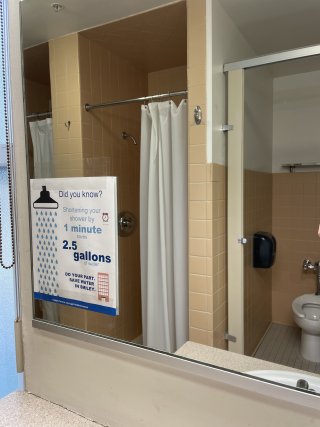Learning about water use in one of the driest states in America
Every year, thousands of college students like me flock to Southern California. From outdoor activities to the hustle and bustle of city life, this area seems to have it all. But, what it doesn’t have is water. All 58 counties in California were under a drought emergency proclamation in 2022, a record dry year for this area. While recent snow and rain have helped, water scarcity is still a major threat. From basic drinking water to the major agriculture industry, California would crumble without water, and drought conditions will only get worse with climate change.
College life can shelter students from how pressing water concerns truly are. The grass on our quad is green – even though the sprinklers that make this possible often leak. My roommate lets the water run, waiting for the shower to “warm up” – even though the hot water heater is directly below our dorm. We’re blind to the impacts of our behavior, as we don’t pay a water bill or see any consequences of our water use.
Influencing Water Habits on Campus

Last November, I designed a poster to advocate for improved water habits on my own California campus, Pomona College. I selected a residence hall with 65 residents using communal bathrooms. I put posters in bathrooms on Dec. 1, highlighting how much water can be saved by taking shorter showers. I wanted to see if providing information would create a greater awareness, ultimately changing behavior.
I planned to calculate water use measurements for each resident in gallons/person/day, comparing gauge data from October (control) to December (after the posters were placed).
In January, I learned that the measurement system had changed, reporting only one data point for mid-November to mid-December. While I was disappointed that the data wasn’t gathered as I had planned, , the reality of the numbers themselves proved to be even more discouraging. Between Nov. 15 and Dec. 15, the residence hall used 62.5 gallons of water/person/day. The previous month, the residents used half as many gallons. The month before that— they used double the amount. When I was reviewing the data, it became clear to me that there are many other factors that influence water consumption.
Building Awareness of Water Usage

Getting people to change their water use habits is more complicated than putting up posters. Just because people are aware of water shortages, does not mean they will change their behavior. Building the future of water conservation will require a multifaceted approach. Technological advancements, such as WaterSense labeled products, and better water usage data are both necessary steps. I know exactly how many gigabytes of data I use on my phone and watts of energy I use in my house, numbers we are forced to acknowledge and pay for at the end of the month. Up until this project I didn’t think about how much water I use – and the cost - and I am confident I’m not alone.
The Public Policy Institute of California Survey states that more than two-thirds of all Californian’s are concerned about the water supply in their part of the state. Fortunately, there are ways even individuals can take action to conserve water.
Take Action
From fixing a leak to daily water conservation, the resources below provide smart and simple actions you can take to stay water smart.
- Learn how to start saving water.
- Explore WaterSense information and discover water use facts.
- Find watering tips for outdoor landscapes.
This project got me thinking about my own water use. Becoming more aware of our behaviors is necessary for taking action for a more sustainable future.

About the Author
Cameron Hodges
Communications Intern
Office of Water
Cameron Hodges is a communications intern at Office of Water. She's been a part of the OW team since August 2022, drafting and writing content for various types of campaigns, from the Clean Water Act Anniversary Tour to EPA’s various technical assistance work. She is a biology major at Pomona College, where she also plays volleyball and runs track. She loves hiking and skiing and her love for the outdoors has prompted her pursuit of a career in environmental science and her involvement with EPA!
Editor’s Note: The views expressed here are intended to explain EPA policy. They do not change anyone’s rights or obligations. You may share this article. However, please do not change the title or the content, or remove EPA’s identity as the author. If you do make substantive changes, please do not attribute the edited title or content to EPA or the author.
EPA’s official web site is www.epa.gov. Some links on this page may redirect users from the EPA website to specific content on a non-EPA, third-party site. In doing so, EPA is directing you only to the specific content referenced at the time of publication, not to any other content that may appear on the same webpage or elsewhere on the third-party site, or be added at a later date.
EPA is providing this link for informational purposes only. EPA cannot attest to the accuracy of non-EPA information provided by any third-party sites or any other linked site. EPA does not endorse any non-government websites, companies, internet applications or any policies or information expressed therein.
